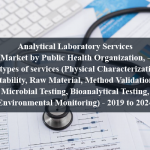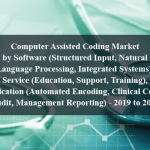OVERVIEW
Research by Global Market Studies has reported a CAGR of 22.4% for the Healthcare Chatbots Market, expecting to expand to a value of USD 7.68 billion by 2028.
The Healthcare Chatbots market comprises companies that use Artificial Intelligence (AI) and Natural Language Processing (NLP) to make chatbots that help patients and healthcare professionals with tasks such as setting up appointments, reminders to take their medications and answering common healthcare questions.
Healthcare Chatbots can be used on many different platforms, like mobile devices, web-based apps and messaging platforms. The market for healthcare chatbots has the potential to change healthcare access by making it more efficient and less expensive.








TABLE OF CONTENT
1 Global Healthcare Chatbots Market
1.1 Study Objectives
1.2 Market Definition
1.3 Study Scope
1.3.1 Markets Covered
1.3.2 Geographic Scope
2 RESEARCH METHODOLOGY
2.1 Research Data
2.1.1 Secondary Data
2.1.1.1 Key Data From Secondary Sources
2.1.2 Primary Data
2.1.2.1 Key Data From Primary Sources
2.1.2.2 Key Industry Insights
2.1.2.3 Breakdown of Primaries
2.2 Market Size Estimation
2.2.1 Bottom-Up Approach
2.2.2 Top-Down Approach
2.3 Market Breakdown and Data Triangulation
2.4 Research Assumptions
3 Global Healthcare Chatbots Market – Executive Summary
3.1 Market Revenue, Market Size and Key Trends by Company
3.2 Key Trends by type of Application
3.3 Key Trends segmented by Geography
4 Global Healthcare Chatbots Market – Comparative Analysis
4.1 Product Benchmarking – Top 10 companies
4.2 Top 5 Financials Analysis
4.3 Market Value split by Top 10 companies
4.4 Patent Analysis – Top 10 companies
4.5 Pricing Analysis
5 Global Healthcare Chatbots Market – Industry Market Entry Scenario
5.1 Regulatory Framework Overview
5.2 New Business and Ease of Doing business index
5.3 Case studies of successful ventures
5.4 Customer Analysis – Top 10 companies
6 Global Healthcare Chatbots Market – Market Forces
6.1 Introduction
6.2 Market Dynamics
6.2.1 Drivers
6.2.2 Opportunities
6.2.3 Challenges
6.3 Porters Analysis of Market
6.3.1 Bargaining power of suppliers
6.3.2 Bargaining powers of customers
6.3.3 Threat of new entrants
6.3.4 Rivalry among existing players
6.3.5 Threat of substitutes
7 Global Healthcare Chatbots Market – Strategic Analysis
7.1 Value Chain analysis
7.2 Product Life Cycle
7.3 Supplier and distributor analysis (Market share and product dealing strategies)
8 Global Healthcare Chatbots Market – By Component (Market Size – & million/billion)
8.1 Services
8.2 Software
9 Global Healthcare Chatbots Market – By Deployment Model
9.1 On-premise Model
9.2 Cloud-based Model
10 Global Healthcare Chatbots Market – By Application
10.1 Symptom Checking & Medication Assistance
10.2 Appointment Scheduling & Medical Guidance
11 Global Healthcare Chatbots Market – By End-User
11.1 Patients
11.2 Healthcare Providers
11.3 Insurance Companies
11.4 Other
12 Global Healthcare Chatbots Market – By Geography (Market Size – & million/billion)
12.1 Introduction
12.2 North America
12.2.1 US
12.2.2 Canada
12.2.3 Mexico
12.3 Europe
12.3.1 U.K
12.3.2 Germany
12.3.3 Italy
12.3.4 France
12.3.5 Spain
12.3.6 Rest of Europe
12.4 Asia-Pacific
12.4.1 China
12.4.2 Japan
12.4.3 India
12.4.4 South Korea
12.4.5 Rest of APAC
12.5 Rest of the World
12.5.1 South America
12.5.2 Middle East
12.5.3 Africa
13 Global Healthcare Chatbots Market – Entropy
13.1 New product launches
13.2 M&A’s, collaborations, JVs and partnerships
14 Global Healthcare Chatbots Market Company Profile (Key Players)
14.1 Market Share, Company Revenue, Products, M&A, Developments
14.2 Your.MD
14.3 Healthtap, Inc.
14.4 Sensely, Inc.
14.5 Buoy Health, Inc.
14.6 PACT Care BV
14.7 Woebot Labs, Inc.
14.8 Infermedica
14.9 Babylon Healthcare Services Limited
14.10 Ada Digital Health, Ltd.
14.11 Baidu
14.12 Company 11 & more
15 Global Healthcare Chatbots Market – Appendix
15.1 Sources
15.2 Abbreviations













